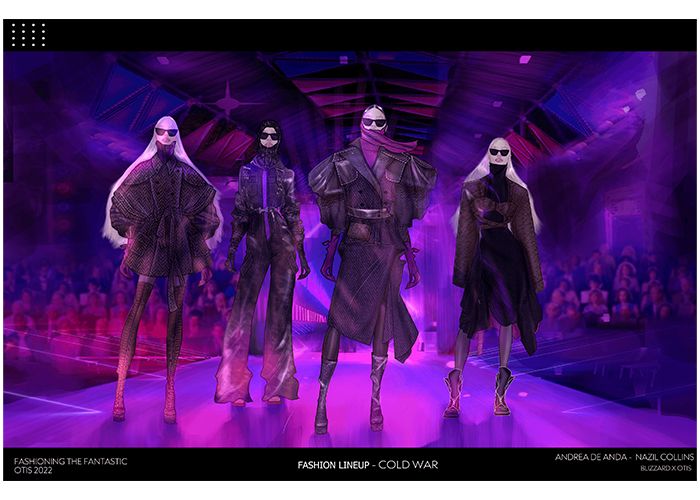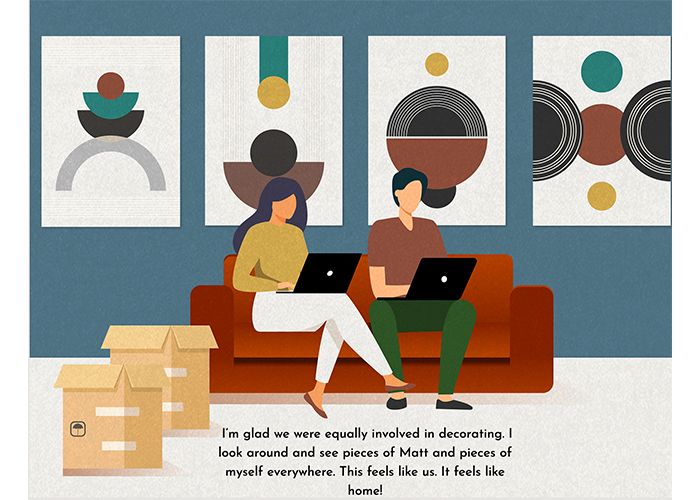An Emphasis on Diversity Digital Curricula and New Offerings like Design Lab Are Investments in a New Otis
Otis College’s academic and administrative leadership are looking toward the next 100 years.
By Anna Raya 
Otis Design Lab’s installation in the Jonathan Louis showroom at High Point Market in North Carolina.
In the summer of 2021, at the largest home furnishings trade show in the world—High Point Market in High Point, North Carolina, comprising 10 million square feet of showroom space (that’s about 1,000 Wal-Marts)— the words “The future is fluid” glowed in white neon from one wall of the Jonathan Louis showroom. Beneath the words was a series of pastel-colored cushioned hexagons that were part of a modular sectional that could be arranged and rearranged in any number of ways. The furniture pieces, dubbed “The Hive,” were designed by Otis College students in one of the first projects undertaken by the Otis Design Lab, a design studio made up of students, staff, and faculty that works with external clients on exciting projects from concept through to production. The students also designed the showroom space where The Hive collection was displayed, from paint swatches to lighting.
In the two years since its launch, Design Lab has overseen projects for prominent clients like TechStyle and the Huntington Library, Art Museum, and Botanical Gardens, among many others.
“At Otis, we have an obligation to our students to prepare them to succeed in the creative economy. Design Lab is a big idea that Otis students should gain professional experience as artists and designers while they are students,” says Otis College President Charles Hirschhorn, who fast-tracked Design Lab despite the College being in the midst of a campus closure at the height of the COVID-19 pandemic. “It was a good idea regardless of the time. The sooner we got it on its feet the better.”
Design Lab is just one of several priorities for President Hirschhorn. Just two years into his tenure and that of Provost Jiseon Lee Isbara—the College has not only surmounted challenges brought on by COVID-19, but is thriving in several crucial ways.
In addition to the success of Design Lab, the undergraduate curriculum is adapting to the growing impact of the digital economy by restructuring the College’s popular Digital Media program into new Animation and Game Design majors. There are several new DEI-centered efforts, such as the Black Creatives Institute and the Charles White Art and Design Scholarship, that are helping to increase access to an art and design education for students of color, while ensuring they feel supported as they pursue their degrees.

Billboards advertising Otis College’s Charles White Art and Design Scholarships throughout Los Angeles County.
Students continue to be at the heart of this forward momentum being forged at the College by Hirschhorn, Lee Isbara, Associate Vice President for Diversity, Equity, and Inclusion (DEI) Nick Negrete, Senior Team, academic leadership, faculty, and staff—all the way up to the Board of Trustees and Board of Governors, members of which often facilitate important partnerships with the College.
Design Lab as an Incubator of Professional Confidence
In addition to completing real-world projects for clients, Design Lab students—who are compensated for their work much as they would be with a paid internship—also gain critical presentation and soft skills, including relationship-building and time management. “If their design experience involves pitching to clients, or attracting new business, or responding, working with, and delivering to clients—that entire experience should not wait for their professional life,” says Hirschhorn. “The sooner they have some experience with that, the better they will be.”
Emily Carlson, Otis College’s Creative Director, who also oversees Design Lab, says the program has attracted students from across undergraduate majors who feel strongly about what they want to do after graduation, yet want to explore and gain real-world skills in a “safe” professional environment. “They want to practice the designer-client relationship—something they learn about in school but don’t have a chance to apply,” she says. “They’re looking for a chance to collaborate with other students because the majority of their coursework at Otis is individual. They also want ‘real work’ in their portfolios because they know it will give them an edge in the job market.”
“Speaking with clients, giving presentations, writing emails, understanding and signing contracts—these are things they’re always nervous about in the beginning, but by the time students leave Design Lab, they have so much professional confidence.”
C.J. Sierra(’21 BFA Product Design), who worked in Design Lab as a Product Design senior, was hired after graduation by Jonathan Louis, where he works as a Product Design Specialist. Adds Carlson, “Another Design Lab student told me she really impressed people in her job interviews by talking about the Jonathan Louis project because the recruiters weren’t expecting her to have experience with clients or with writing creative briefs. She was ahead of the curve the moment she started.”
An additional outcome for Design Lab students is confidence. “Speaking with clients, giving presentations, writing emails, understanding and signing contracts—these are things they’re always nervous about in the beginning, but by the time they leave Design Lab, they have so much professional confidence,” says Carlson.
Design Lab students are also gaining confidence in the fact that their work can “cut it” in the real world. “When the client chooses their design direction over others, or says, ‘Wow, I didn’t know what to expect, but this is incredible!,’ that’s powerfully validating because it’s not a teacher praising them inside this Otis bubble—it’s real work for a real client. It tells them they have what it takes,” says Carlson.
Adapting to the Digital Times

Otis College Fashion Design students Andrea DeAnda and Nazil Collins created these runway looks for Activision’s Call of Duty franchise, which were shown during O-Launch ’22 weekend last May.
Another crucial way that Otis College is preparing students for thriving careers in the ever-expanding creative economy is by incorporating digital applications of art and design into the classroom in new and enterprising ways. Recently, the College partnered with Activision, the game design company behind the Call of Duty, Tony Hawk, and Skylanders franchises, among others, for a project spanning the Fashion Design and Digital Media programs. Taking inspiration from three Call of Duty games—Cold War, Modern Warfare, and Infinite Warfare—Fashion Design students developed a digital fashion collection in 3D form, using a program called Marvelous Designer. The Digital Media students created custom “environments” for the looks, and together they created a high-fashion digital runway collection that was shown during last Spring’s O-Launch ’22, the College’s culminating exhibition of student work.
“We continue to excel in teaching physical, hands-on art and design, but we’re also investing in teaching digital art and design.”
Otis College’s Fashion Design and Digital Media departments collaborated with Activision Blizzard on an exciting and unprecedented project in Spring 2022. Students took inspiration from one of three Call of Duty games (Cold War, Modern Warfare, or Infinite Warfare) to create a high-fashion runway collection. Fashion Design students took it a step further by producing looks in 3D form, using Marvelous Designer. Digital Media students created custom-designed “environments” for the project.
“We continue to excel in teaching physical, hands-on art and design, but we’re also investing in teaching digital art and design,” says Hirschhorn. “It’s not just digital media, or video game design, or animation, it’s also digital fashion design, digital environmental design, digital product design, and digital toy design. We want to see that as a component of our curriculum so that students are prepared to enter existing art and design fields, but also future art and design fields.”
Restructuring the Digital Media program into separate Animation and Game Design programs is another adaptation the College is making in response to a digital industry that is extraordinarily dynamic, ensuring a remarkable future for the program’s advancement, both in its curricular content and students’ growing interest.

Activision’s Tim McGrath reviews work by Otis College Fashion Design students.
“Los Angeles is the center of the creative industry that provides excellent social mobility opportunities for our students. I am excited to witness how our Digital Media curriculum is reimagined to enhance digital technology skills that will prepare our students for this innovative and expanding field of industry,” Provost Lee Isbara says.
“Animation is a field that is always evolving with new techniques and software, so our program needs to prepare students to be innovative, flexible, and adaptive with changing tides,” says Ron Bernard, the new Chair of Animation, who started at Otis College this Fall. “That said, I would like our program to also be specialized so our students won’t be lost in the sea of ‘generalist’ animators. I’d like to explore some of the newer fields of virtual production, social media, and augmented reality. There are things happening now with Unreal Engine and motion capture that are truly amazing and will create a paradigm shift on how we approach animation.”
Bernard sees Otis College graduates continuing into the more traditional fields of character animation and visual effects, but also says there is a spectrum of inspiring jobs in animation across the board, from education, military, medicine, and social media.
Likewise, Joffery Black, the new Chair of Game Design, who also started at Otis College this Fall, says a skillset in this new major can expand to multiple sectors of the industry. “The new BFA program in Game Design will give students an opportunity to learn practices and techniques that have been part of the game industry for the last decade,” Black says. “The plus side of these skills is that they translate into careers for the next frontier of real-time development jobs, such as mobile and console games, virtual reality and augmented reality, virtual production, Web 3.0, and the metaverse.”
“It is a unique advantage to be agile with an educational program; as industry trends change, so can we to best serve our students.”And while Otis College has always been on the cutting edge of preparing students to thrive in the creative economy, so too has Otis Extension worked from the same set of values for its continuing learners, adapting courses and certificate programs to emerging and changing industries, including a new workshop, How to Turn Your Art into an NFT (non-fungible tokens, a new frontier in digital art and design), and a recently-launched certificate program in UX/UI for Web Design.
“I would characterize our ability to adapt to emerging industries to be one of the greatest assets of our certificate programs,” says Terry Nauheim, Otis Extension’s Director of Curriculum. “It is a unique advantage to be agile with an educational program; as industry trends change, so can we to best serve our students with knowledge and portfolios relevant to entry-level positions in current and emerging fields.”
A Future Steeped in Legacy
Just as President Hirschhorn has been looking toward the future of Otis College, he’s also reflected back on its past and the legacy of Charles White, who was an instructor and eventual chair of the drawing department at what was then known as Otis Art Institute. “If you were an artist of color west of the Mississippi, you wanted to come to Otis and you wanted to learn from Charles White,” Hirschhorn says, referring to such esteemed Otis alumnx as Kerry James Marshall (’78 MFA Fine Arts), Judithe Hernández (’74 BFA Fine Arts), Ulysses Jenkins (’79 MFA Fine Arts), and David Hammons (’72 Fine Arts), all of whom studied under White. “One of the goals that we have had recently is to return Otis to a place where it was a generation ago. Charles White helped create a legacy of extraordinary artists of color that have grown to great prominence today.”

Otis College faculty member Charles White in his studio, left, and with former student Judithe Hernández (’74 BFA Fine Arts), right. Image courtesy of the Charles White Archives Inc.
Some of these efforts have included the launch of the Black Creatives Institute and BIPOC Summit—the goals of which are to create an inclusive and supportive environment for students of color with an eye toward personal growth, identity formation, cultural development, and career development—as well as Summer of Style, an immersive, pre-college program in fashion, product design, and interior design for underrepresented high school students developed in partnership with Hollywood stylist and entrepreneur Jason Bolden.
Last year also saw the establishment of the Charles White Art and Design Scholarship, a four-year award that is funded by a generous gift from Board of Trustees Chair Mei-Lee Ney and is awarded to two students from underrepresented backgrounds every year: one from Los Angeles County, and another from anywhere in the United States. The scholarship’s inaugural recipient began their studies at Otis College this Fall.
“We’re a very diverse student body, but we’ve under-invested in our Black student body and our Black faculty,” says Hirschhorn. “In the last couple of years we’ve been able to address some of those issues. It’s very early, but, nonetheless, I think we’re starting to see some positive results just in terms of the number of new students of color and new faculty, and the number of participants in the Black Creatives Institute.”
To this end, Nick Negrete was announced as the new Associate Vice President of Diversity, Equity, and Inclusion last year, after spending four years in Student Affairs at the College, first as associate dean and then dean. Negrete’s purview now includes DEI training and support for faculty and staff, developing plans for a physical Center for DEI at Otis, and programs to increase the College’s diverse student body, faculty, and staff.

Otis College students attend the Black Creatives Institute. Photograph by Jennifer Atalla/Otis College of Art and Design.
“Our students of color have noticed much more programming efforts that validate their experiences and have expressed appreciation for that,” Negrete says. “I have also heard from students that they have seen a much more diverse student population that has made them feel more connected and in community with each other, which contributes to an overall sense of belonging. This is huge when you think about what it means to make a place like Otis feel like your own.”
That sense of belonging has been another important area of focus for the College, especially since the return to campus after the COVID-19 closures last year. The amount of work being done to fully realize goals surrounding diversity, digital, and the growth of Design Lab ensure that the future for Otis College students will continue on the equitable, supported, and career-ready path being forged today.









